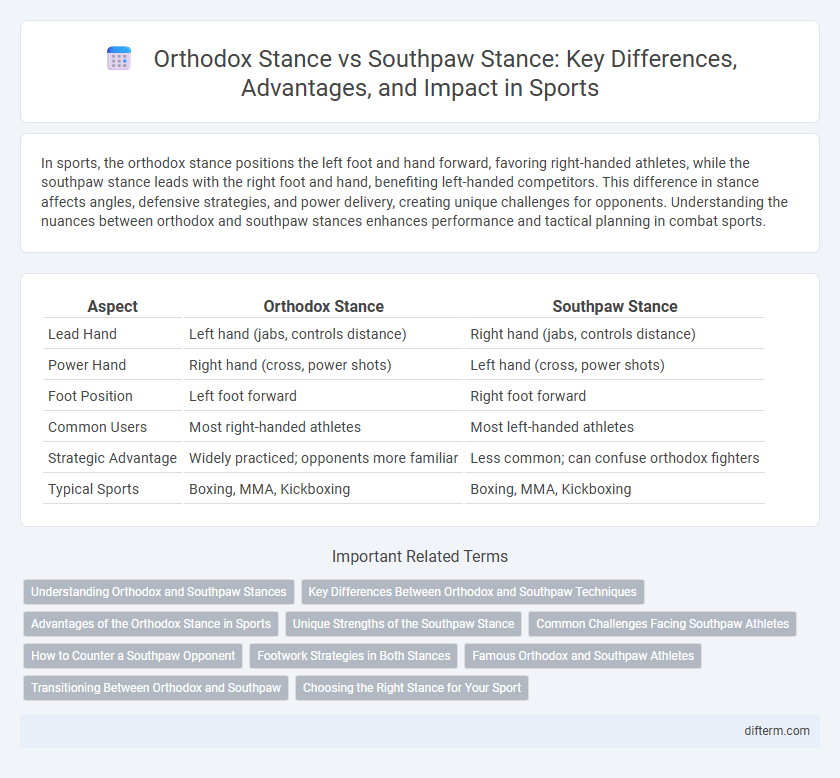In sports, the orthodox stance positions the left foot and hand forward, favoring right-handed athletes, while the southpaw stance leads with the right foot and hand, benefiting left-handed competitors. This difference in stance affects angles, defensive strategies, and power delivery, creating unique challenges for opponents. Understanding the nuances between orthodox and southpaw stances enhances performance and tactical planning in combat sports.
Table of Comparison
| Aspect | Orthodox Stance | Southpaw Stance |
|---|---|---|
| Lead Hand | Left hand (jabs, controls distance) | Right hand (jabs, controls distance) |
| Power Hand | Right hand (cross, power shots) | Left hand (cross, power shots) |
| Foot Position | Left foot forward | Right foot forward |
| Common Users | Most right-handed athletes | Most left-handed athletes |
| Strategic Advantage | Widely practiced; opponents more familiar | Less common; can confuse orthodox fighters |
| Typical Sports | Boxing, MMA, Kickboxing | Boxing, MMA, Kickboxing |
Understanding Orthodox and Southpaw Stances
The orthodox stance, favored by right-handed athletes, positions the left foot and hand forward to maximize power in the rear right hand, while the southpaw stance, used primarily by left-handed fighters, places the right foot and hand forward to create angles that disrupt typical defense strategies. Understanding the tactical differences between these stances is crucial for effective offense and defense, as southpaw fighters often exploit their uncommon positioning to counter orthodox opponents. Mastery of footwork, balance, and punch positioning in each stance enhances strategic advantages during competition.
Key Differences Between Orthodox and Southpaw Techniques
Orthodox stance, predominantly used by right-handed athletes, positions the left foot and hand forward to maximize power and reach with the dominant right hand. Southpaw stance, favored by left-handed competitors, reverses this alignment, leading with the right foot and hand to create strategic angles and exploit opponents' orthodox defense. Key differences include foot placement, lead hand usage, and defensive maneuvers, impacting punching combinations and counterattack effectiveness in boxing and mixed martial arts.
Advantages of the Orthodox Stance in Sports
The orthodox stance in sports provides a strategic advantage for right-handed athletes by positioning their dominant hand and foot forward, enhancing power and control in striking or movement. This stance enables better balance and defensive capabilities, making it easier to guard against opponents' attacks while delivering precise blows. Familiarity with the orthodox stance also allows athletes to develop more consistent footwork and leverage, crucial for maintaining dominance in competitive scenarios.
Unique Strengths of the Southpaw Stance
The southpaw stance offers a unique advantage due to its rarity, often confusing orthodox fighters unaccustomed to its angles and timing. Southpaws capitalize on the lead right jab and powerful left cross, generating unexpected offensive opportunities. This stance also provides a strategic edge in foot positioning, enabling better control of the ring and optimal attack angles.
Common Challenges Facing Southpaw Athletes
Southpaw athletes often encounter challenges such as limited sparring partners due to the prevalence of orthodox fighters, which can hinder their training effectiveness. Their unorthodox stance requires unique footwork and defensive strategies to counter orthodox opponents who are unaccustomed to facing left-handed fighters. This tactical disadvantage demands specialized coaching and adaptation to exploit opportunities while mitigating vulnerabilities in competitive sports like boxing and mixed martial arts.
How to Counter a Southpaw Opponent
To counter a southpaw opponent effectively, orthodox fighters should focus on maintaining outside foot positioning to gain strategic angles and reduce vulnerability to power shots. Controlling the center of the ring and utilizing a jab to disrupt the southpaw's rhythm limits their offensive opportunities. Emphasizing quick head movement and counterpunching exploits openings created by the southpaw's lead right hand.
Footwork Strategies in Both Stances
Orthodox stance fighters typically lead with their left foot, emphasizing strong forward and lateral movement to control distance and angle attacks. Southpaw fighters place their right foot forward, leveraging foot placement to create offensive opportunities and evade power shots from orthodox opponents. Mastering footwork in both stances involves strategic pivoting and maintaining balance, crucial for effective positioning and counterattacks.
Famous Orthodox and Southpaw Athletes
Famous orthodox stance athletes include Muhammad Ali and Floyd Mayweather Jr., who demonstrated exceptional power and technique using the traditional right-handed style. In contrast, legendary southpaw fighters like Manny Pacquiao and Pernell Whitaker leveraged their left-handed stance to create unpredictable angles and confuse opponents. The strategic advantages of each stance make matchups between orthodox and southpaw boxers highly dynamic and technically complex.
Transitioning Between Orthodox and Southpaw
Transitioning between orthodox and southpaw stances demands precise footwork and muscle memory retraining to maintain balance and power in strikes. Effective switching enhances unpredictability, allowing athletes to exploit opponents' weaknesses by altering attack angles and defensive positioning. Fighters often incorporate drills that emphasize shadowboxing and sparring from both stances to build fluidity and adaptability in competitive scenarios.
Choosing the Right Stance for Your Sport
Choosing the right stance, orthodox or southpaw, significantly impacts performance in sports like boxing and martial arts by influencing balance, power delivery, and defensive strategies. Orthodox stance suits right-handed athletes, maximizing their dominant hand for strong jabs and crosses, while southpaw stance benefits left-handed competitors by offering strategic advantages against orthodox opponents. Understanding the tactical differences and personal comfort with foot positioning helps athletes optimize speed, leverage, and reaction time in competitive scenarios.
orthodox stance vs southpaw stance Infographic

 difterm.com
difterm.com